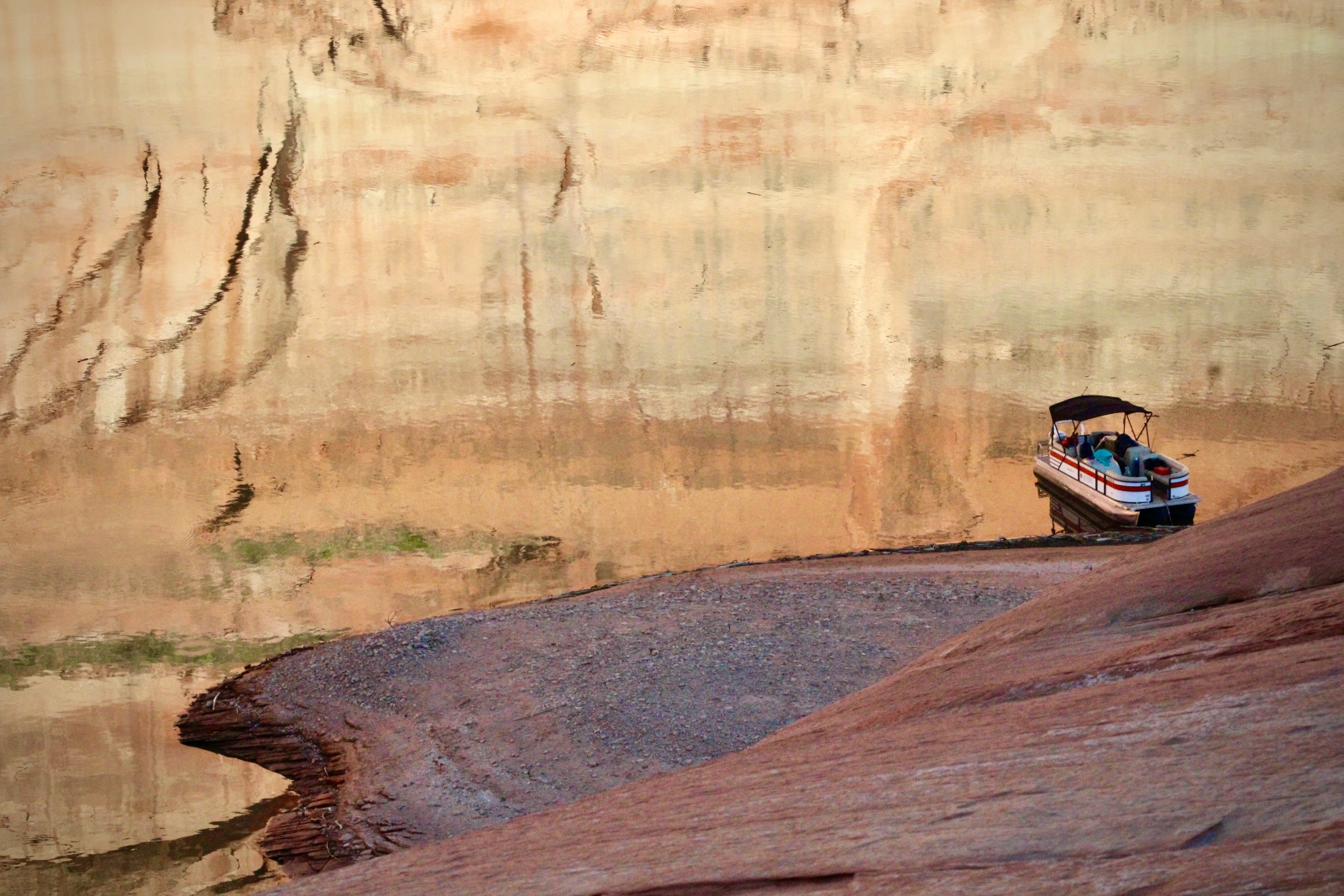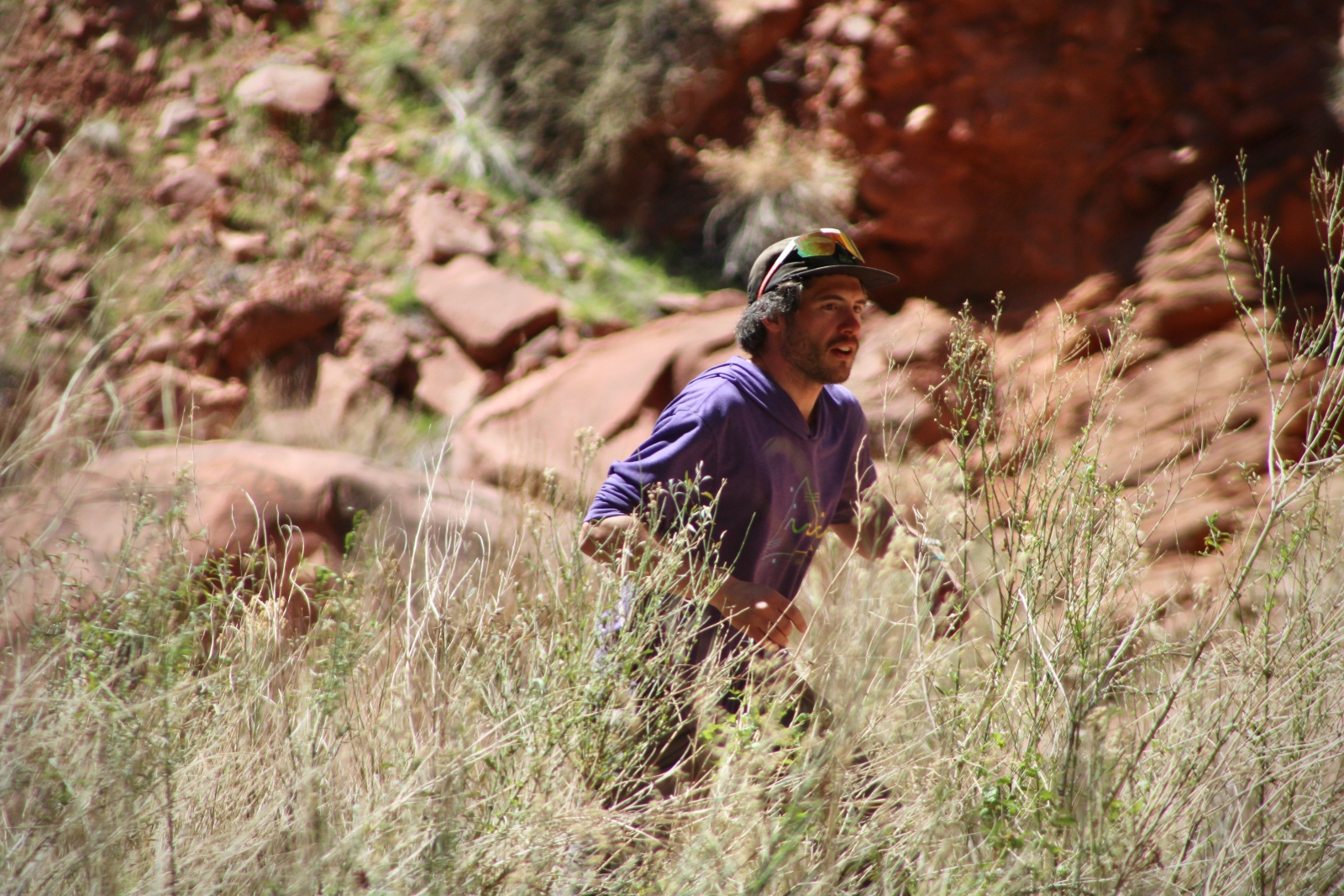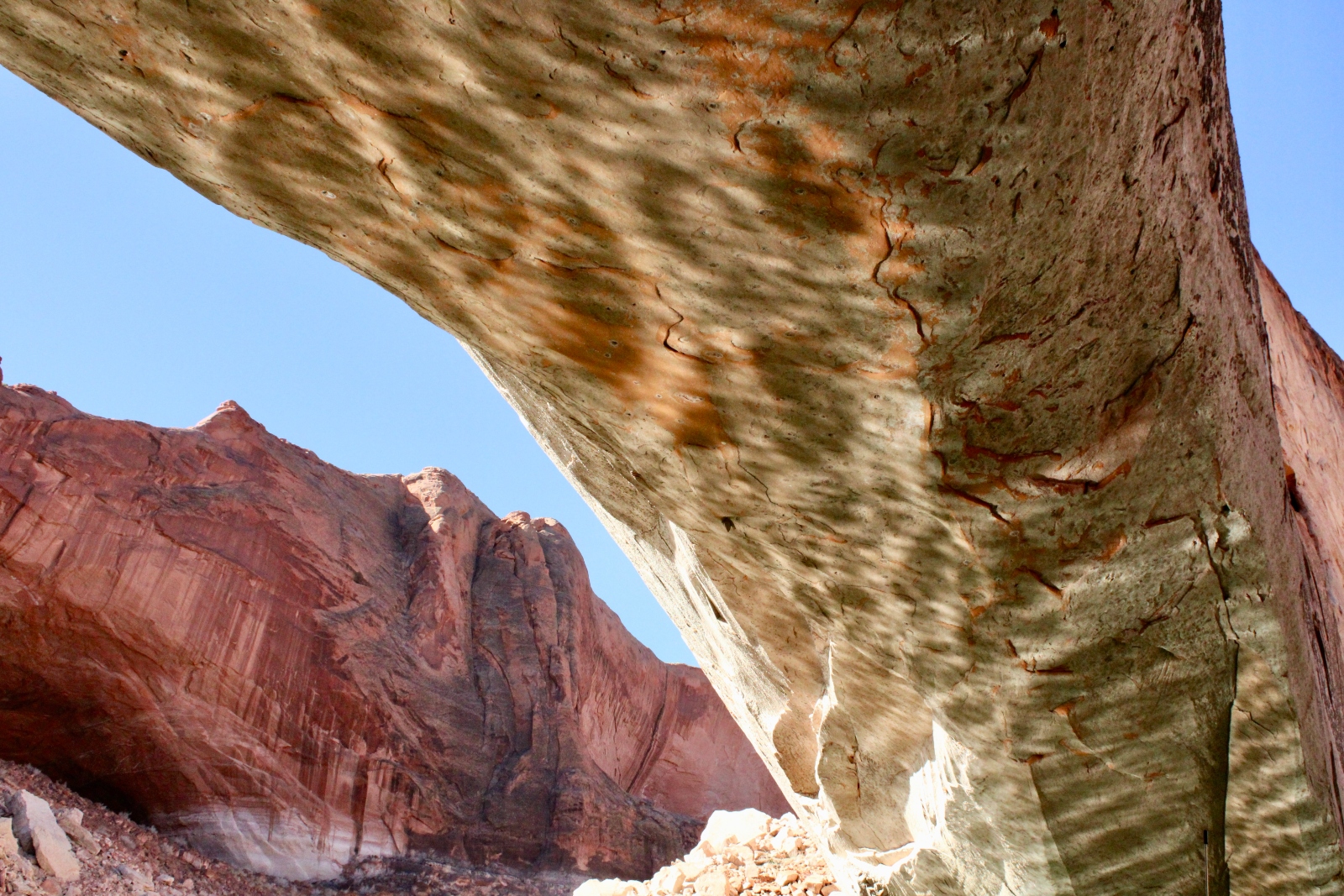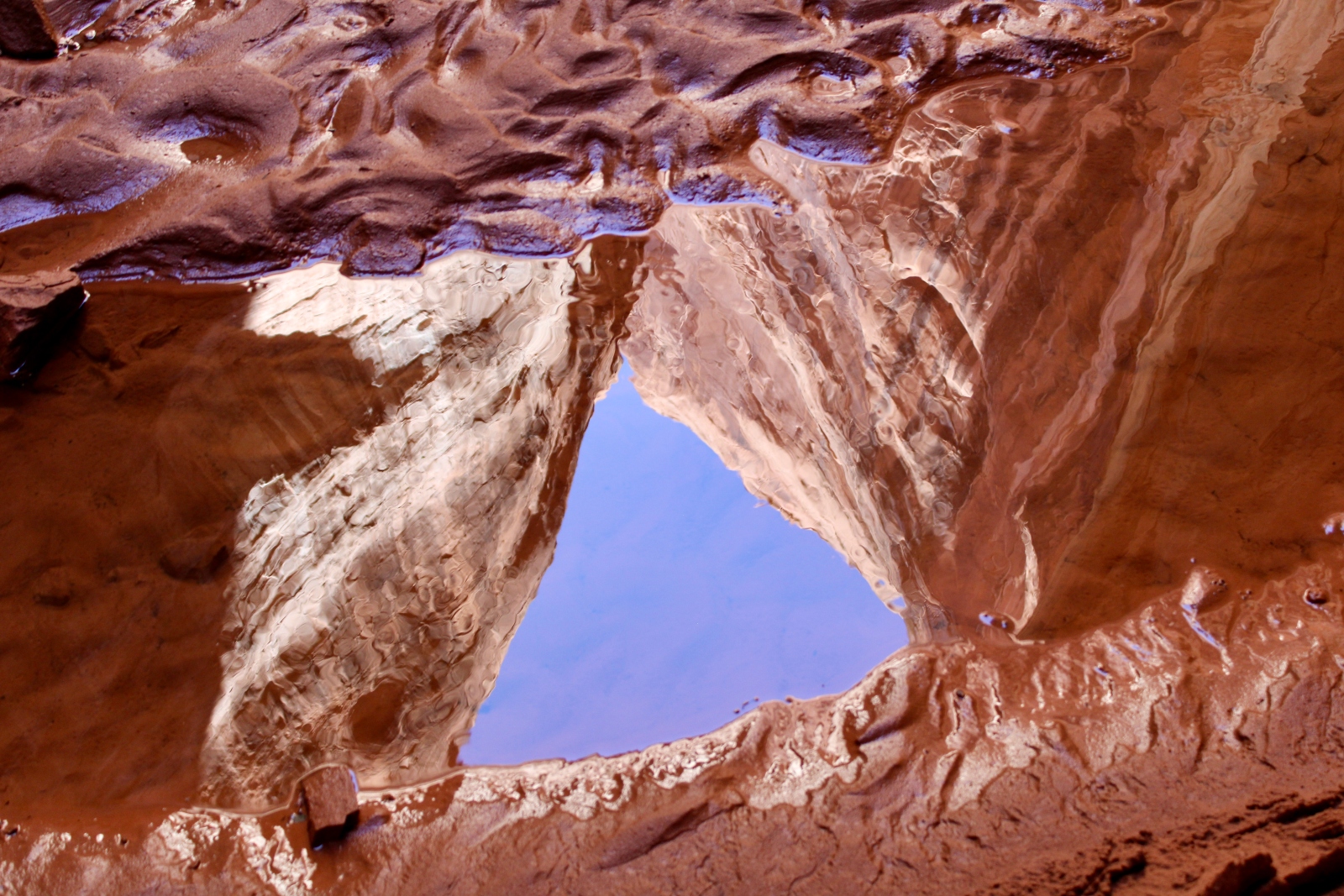As the nation’s second-largest reservoir recedes, a once-drowned ecosystem emerges
If you want to see the Colorado River change in real time, head to Lake Powell.
At the nation’s second-largest reservoir, water levels recently dipped to the lowest they’ve been since 1968. As the water recedes, a breathtaking landscape of deep red-rock canyons that cradle lush ecosystems and otherworldly arches, caverns and waterfalls is emerging.
On a warm afternoon after the reservoir had dipped to a record low, Jack Stauss walked along a muddy creek bed at the bottom of one of those canyons. He works as the outreach coordinator for Glen Canyon Institute, a conservation nonprofit that campaigns for the draining of the reservoir and highlights the natural beauty of Glen Canyon, which was flooded in the 1960s to create Lake Powell.
“I call this the moon zone,” Stauss said, as his shin-high rubber boots splashed through cold pools and eddies. “There are ecosystems that thrive in these side canyons, even when they’ve been de-watered for just, like, four years. You start to see stuff come back on a really unprecedented scale.”

Alex Hager / KUNC
Lake Powell is already receiving a major springtime boost. Until July, snow from an epic winter in the Rocky Mountains will melt and flow into the reservoir, and portions of those side canyons will flood anew. But for a brief moment in the late winter and early spring of 2023, Powell was creeping lower by the day. The falling water levels have created a harrowing visual reminder. Climate change has put the West’s key water supply on the ropes. At the same time, the drop reveals a spectacular landscape that environmentalists have heralded as a “lost national park.”
Stauss – an environmentalist who refers to Lake Powell as “the reservoir” – invited a small group of adventurous water wonks to chronicle its historically low water levels. He ambles along through the ankle-deep water, pointing up toward the infamous “bathtub rings,” chalky white mineral deposits on the canyon walls that serve as visual markers of the reservoir’s heyday.
“It’s staggering,” Stauss said. “The scale is hard to wrap your head around. The fact that the whole time we were just hiking, we would have been underwater, is shocking.”
The high water line, set in the early 1980s, is more than 180 feet above our heads. Even last summer’s high water mark is about eye level.
Reminders of Glen Canyon’s return to some form of pre-reservoir normal aren’t always as static as the bathtub rings on canyon walls. All around our feet, the shallow water teems with life. The crystal-clear creeks are full of spindly bugs that float on the water’s surface. Occasionally, toads jump from the stream’s sandy banks. Lizards bask in patches of sun. Bird calls echo off the smooth walls and melt into a distorted chorus.
Teal Lehto, who makes short videos about the Colorado River on TikTok under the name “WesternWaterGirl,” was also on the expedition. She pushed past a dense thicket of willows as we hiked through the canyon.
“It’s really, really interesting seeing the way that the ecosystem is recovering,” Lehto said. “And then there’s a little bit of heartbreak knowing that this area is probably going to be submerged again in a couple of months.”
After spending decades under mostly-still water, these canyons are laden with heaps of sediment that settled onto on the lake’s floor. Towering, crumbly banks of sand and dirt line the bottom of each side canyon, often high enough that some of the group’s ski enthusiasts try to carve down, sliding across the loose deposits in their sandals.
As those sandy banks start to erode, they also reveal traces of human activity. Old beer cans, golf balls, and other tattered bits of unidentifiable trash poke through the sediment, leaving lasting reminders of Powell’s double-life: a bustling haven for recreation, and a key piece of water storage infrastructure.

Alex Hager / KUNC
‘Nature bats last’
The group’s boat – a rented pontoon boat with plenty of space for the camera gear, camping setups and loaded coolers we’ve piled towards the back – wasn’t particularly agile. Stauss carefully piloted the craft through a “ghost forest,” where the blackened, skeletal tips of cottonwood trees are just seeing the light of day after decades underwater.
“Every time you come down here, it’s sort of a different game of steering the boat through stuff,” he said. “It’s kind of exciting, actually, like a little puzzle.”
After a slow cruise around the eerie labyrinth of treetops, Stauss leaned the accelerator back into neutral. The boat idled in front of the messy, muddy delta of the Escalante River. The river carries snowmelt about 90 miles through Southeast Utah before it runs into Lake Powell, in an area which was once the free-flowing Colorado River.
Another member of the expedition, Len Necefer, was in this same spot last year. Necefer, a member of the Navajo Nation, founded the consulting and media group NativesOutdoors and holds a PhD in engineering and public policy.
“It’s constantly changing,” he said. “In a few weeks you’ll be able to motor around and go up to Willow Canyon and all that. But right now it’s in this sort of crazy zone of transition.”
The group ponders a trek out onto the delta itself but decides against venturing into the mud, where footing looks uncertain. As the boat cruised into a U-turn, Necefer posited that “nature bats last.”
“Bottom of the ninth, end of a baseball game, nature is at bat and basically has the final say on what happens,” he said.
Nature is taking its last licks in nearly every corner of the sprawling reservoir. Elsewhere, a natural stone arch, once completely submerged, is now so high above the water that you can drive a boat underneath.

Alex Hager / KUNC
At the reservoir’s marinas, receding water has thrown a curveball to Lake Powell’s powerhouse recreation industry. In 2019, Glen Canyon National Recreation Area attracted 4.4 million visitors, more than Yellowstone National Park. The National Park Service says tourism brought $502.7 million to local economies.
But the recreation area – a world-renowned hotspot for houseboaters, wakeboarders, and jet skiers – has taken a hit.
At marinas along Lake Powell, the distance between the parking lot and the shore of the reservoir has gotten dramatically longer over the past two decades.
At Bullfrog Marina, where Stauss rented the pontoon boat, what was once a gentle ramp right next to the parking lot is now a strip of concrete hundreds of feet long. Docks and buoys once moored in water dozens of feet deep now lie crooked and dusty on the desert ground.
In the past few years, the National Park Service has had to make the Bullfrog Marina ramp even longer, chasing the water as it recedes. Further upstream, the Hite Marina, once a busy put-in for boats, is stranded so far away from the water that it is now shuttered.

‘Speechless’ at the Cathedral
Each hike into a new side canyon was the same. Stauss pushed the bow of the pontoon boat into the muddy shore, and the group hopped out clad with backpacks full of cameras. At each new mooring, the path was only visible a few dozen yards up the canyon before a dramatic curve obscured the route ahead.
On one hike, an extra-squishy patch of mud turned out to be quicksand. The trekkers tap danced across it, careful not to sink too deep, but egged each other on to test its limits. Filmmaker Ben Masters, a member of the expedition, wriggled around until he was waist deep and needed a hand to get unstuck.
“Indiana Jones taught me to stop resisting,” Lehto said as Masters pulled himself out of the muck.
After about a half hour of strolling, the crew got what it came for – a rare glimpse of Cathedral in the Desert.
Awe-inspiring as they are, the side canyons can blur together after a few hours of plodding through relatively indistinct curves in the rock.
This one is different.
The hikers round a corner and come upon a red-rock cavern. The group, chatty on the way in, falls silent for a moment.

Alex Hager / KUNC
“I’m kind of speechless, which is really funny for me, because I always have something to say,” said Lehto, the TikTok creator. “But it is gorgeous. It’s amazing to me to imagine that this was all underwater, and it will be underwater again soon.”
The canyon tapered into a kind of dome, where only narrow slivers of sunlight peek through. In one corner, at the foot of a giant sand mound, a thin waterfall trickled from above. The rivulet snaked through a crack in the rock before it dribbled into a frigid, still pool and echoed through the cavern.
“I kind of wish there was a choir here because I think it would be really beautiful,” Lehto said. “Anybody know how to sing?”
Nobody in the group chimes in. Most are silent, staring up toward the top of the waterfall and contemplating the best way to position their cameras.
After a few minutes of silent marveling, Stauss provides some context.
Cathedral in the Desert made a brief above-water appearance in 2005, only to be submerged again until 2019. Since then, fluctuating water levels have flooded in and out of the pocket, limiting the waterfall’s height.
“People used to boat up 100 feet above the waterfall,” he said. “It’s something we’ve been waiting for for a long time. It’s another one of these markers of restoration to see Cathedral come back and to know that it’s not just a fraction of what it once was, but it’s going to be full size.”
After the fall, a rise
Standing under the Cathedral’s ceiling of smooth desert stone, Stauss pondered the future of a region where Lake Powell, and the rest of the Colorado River’s sprawling network of storage infrastructure, are due for an overhaul.
“I don’t think we should just think that the drawdown of these reservoirs is over,” he said. “I think we should use the moment to rethink completely how we store, use and conserve water across the West—and I think Glen Canyon should be at the heart of that conversation.”

Alex Hager / KUNC
In some circles, Glen Canyon is a major thread in conversations about water management. Environmentalists argue that Powell should be drained and Glen Canyon should be allowed to return completely. Recreators disagree, and water managers have shown reluctance to break so sharply from the status quo.
But the Colorado River’s rapid drying has pushed the idea of draining Lake Powell from the fringe and given a semblance of legitimacy to water management ideas once considered far-fetched. The river, which supplies tens of millions across the Southwest, has faced dry conditions since around 2000. The seven U.S. states which share its water have been caught in a standoff about how to cut back on demand.
This year, deep mountain snow promises a serious boost, the likes of which have only been seen a handful of times in the past two decades. Runoff is expected to raise the reservoir’s surface by about 50 to 90 feet by this July.
But even the most cautious runoff estimates would leave the reservoir less than 40 percent full. Its levels will again begin to drop over the fall and winter.
One year of strong snow won’t be nearly enough to pull the reservoir out of trouble. Climate scientists say the Colorado River would need five or six winters like this one to rescue its major reservoirs from the brink of crisis.
The past few springs delivered relatively low runoff, leading to summers fraught with mandatory water cutbacks and emergency releases from smaller reservoirs – efforts primarily focused on keeping water in Lake Powell.

Alex Hager / KUNC
Water managers are under pressure to keep water flowing through hydroelectric turbines within Glen Canyon Dam, which holds back Powell. After decades as a rock-solid emblem of the nation’s Cold War era expansion into the West, dropping water levels are threatening one of the dam’s primary functions. If water dips too low, the federal government could be forced to shut off hydropower generators that supply electricity to 5 million people across seven states.
This wet winter will ease some of that pressure, although water managers have publicly emphasized the need to avoid “squandering” the benefits of an unusually snowy year. The favorable conditions could relieve the need for emergency changes to Colorado River management, allowing the seven states which share its water to wait until 2026 for broader changes. The current operating guidelines for the river are set to expire that year, and water managers are expected to come up with more permanent cutbacks to water demand before that happens.
Amid tense negotiations and pre-2026 posturing, environmentalists like Stauss and his colleagues at Glen Canyon Institute are arguing for a future which cuts out a need for Lake Powell entirely – decommissioning Glen Canyon Dam and storing Powell’s water in other reservoirs.

Alex Hager / KUNC
In the meantime, Stauss relished the brief glimpse at what that might look like.
“It’s a scary future for water in the West,” he said. “But as far as Glen Canyon goes, it’s a pretty amazing silver lining.”
This story is part of ongoing coverage of the Colorado River, produced by KUNC, and supported by the Walton Family Foundation.
This story was originally published by Grist with the headline As the nation’s second-largest reservoir recedes, a once-drowned ecosystem emerges on Jun 3, 2023.


